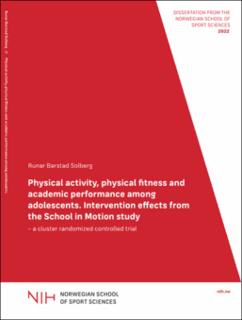| dc.contributor.author | Solberg, Runar Barstad | |
| dc.date.accessioned | 2022-05-24T12:24:41Z | |
| dc.date.available | 2022-05-24T12:24:41Z | |
| dc.date.issued | 2022 | |
| dc.identifier.isbn | 978-82-502-0603-8 | |
| dc.identifier.uri | https://hdl.handle.net/11250/2995947 | |
| dc.description.abstract | Introduction: Emerging evidence suggests a favourable relationship between physical activity, aerobic fitness and academic performance. Recent data show that physical activity levels decrease through adolescence, whilst only 50% of Norwegian 15-year-olds are sufficiently active meeting physical activity guidelines of ≥ 60 minutes in moderate-to-vigorous intensity physical activity (MVPA) per day. Accordingly, there is a need to develop interventions that can effectively change behaviour, leading to increased physical activity, physical fitness and academic performance among adolescents.
Aims: This thesis is based on a school-based, physical activity cluster randomized controlled trial (RCT) titled School in Motion (ScIM). This thesis investigates the intervention effects of ScIM on adolescents’ physical activity level, physical fitness and academic performance. Further, we explored whether aerobic fitness mediated the intervention effects of physical activity on academic performance. Finally, we wanted to explore the associations between teacher-reported contextualised factors and intervention dose delivered.
Methods: ScIM was a nine-month cluster RCT. In total 30 Norwegian secondary schools were randomized to one of three study arms; the physically active learning (PAL) (n = 10); the Don’t worry-Be happy (DWBH) intervention (n = 10); or control (n = 10). The PAL intervention included 30 min physically active learning, 30 min physical activity and a 60 min physical education (PE) lesson per week. The DWBH intervention included a 60 min physical activity lesson and a 60 min PE lesson per week. Both components in the DWBH intervention was tailored to promote friendships and wellbeing. The control group continued as usual, including the standard amount of mandatory PE. The PAL and DWBH interventions were designed to engage the adolescents in 120 min of physical activity per week in addition to recess and mandatory physical education (PE) lessons. Parental consent was obtained from 2,084 adolescent students (76%). Physical activity (main outcome) was assessed by accelerometers; physical fitness and muscle strength were assessed by an intermittent running test and selected tests from the Eurofit test battery; whilst standardized national tests in reading and numeracy was used to assess academic performance. Teacher related contextualized factors were self-reported once by teachers after randomisation, but prior intervention start. All other measurements were conducted at baseline and at the end of the intervention.
Results: Physical activity levels decreased in all three groups throughout the intervention. We found significant mean difference in change in physical activity (counts per minute 34.7, 95% Confidence interval (CI): 4.1 to 65.3; moderate-to-vigorous intensity physical activity 4.7 min, 95% CI: 0.6 to 8.8) and aerobic fitness (19.8 m, 95% CI: 10.4 to 29.1) among adolescents in the PAL intervention compared with controls.
No evidence was found for this in the DWBH intervention. Academic performance increased among adolescents in both interventions when compared with controls. The mean difference in change in numeracy was 1.7 (95% CI: 0.9 to 2.5) and 2.0 (95% CI: 1.4 to 2.7) points in favour of students in the PAL and DWBH intervention, respectively. For reading the mean difference in change was 0.9 (95% CI 0.2 to 1.6) and 1.1 (95% CI 0.3 to 1.9) points in favour of students in the PAL and DWBH intervention, respectively. Further, aerobic fitness did mediate the effects on academic performance in the PAL intervention, but not in the DWBH intervention. Finally, we found no associations between teacher related contextualized factors and dose delivered.
Conclusion: The results from this thesis has shown that implementing two hours of extra physical activity among adolescents have several positive effects. The PAL intervention is effective in curbing the decline in physical activity observed throughout adolescents, whilst also increasing the adolescent’s aerobic fitness. Furthermore, both the PAL and DWBH interventions have proven to be feasible methods to increase academic performance among adolescents. As aerobic fitness mediated the intervention effect on academic performance in the PAL intervention, physical activity of an intensity that increases aerobic fitness is one strategy to improve academic performance among adolescents. | en_US |
| dc.language.iso | eng | en_US |
| dc.relation.haspart | Paper I: Kolle, E., Solberg, R.B., Säfvenbom, R. et al. The effect of a school-based intervention on physical activity, cardiorespiratory fitness and muscle strength: the School in Motion cluster randomized trial. Int J Behav Nutr Phys Act 17, 154 (2020). https://doi.org/10.1186/s12966-020-01060-0 | |
| dc.relation.haspart | Paper II: Solberg RB, Steene-Johannessen J, Anderssen SA, Ekelund U, Säfvenbom R, Haugen T, Berntsen S,
Åvitsland A, Lerum Ø, Resaland GK, Kolle E. Effects of a school-based physical activity intervention on academic performance in 14-year old adolescents: a cluster randomized controlled trial - the School in Motion study. BMC Public Health. 2021 May 6;21(1):871. doi: 10.1186/s12889-021-10901-x. PMID: 33957895; PMCID: PMC8101111. | |
| dc.relation.haspart | Paper III: Solberg RB, Steene-Johannessen J, Wang Fagerland M, Anderssen SA, Berntsen S, Resaland GK, Van Sluijs MF E, Ekelund U, Kolle E. Aerobic fitness mediates the intervention effects of a school-based
physical activity intervention on academic performance. The School in Motion study – a cluster randomized controlled trial. Preventive Medicine Reports, 24, 101648 (2021). doi:https://doi.org/10.1016/j.pmedr.2021.101648 | |
| dc.relation.haspart | Paper IV: Solberg RB, Steene-Johannessen J, Resaland GK, Tjomsland H, Van Sluijs MF E, Haugen T, Grydeland
M, Lerum Ø, Kolle E. Teacher-reported contextual factors are not associated with the intervention dose delivered: A quantitative implementation assessment of a school-based physical activity intervention. [Manuscript submitted]. | |
| dc.subject | nih | en_US |
| dc.subject | doktoravhandling | en_US |
| dc.title | Physical activity, physical fitness and academic performance among adolescents: Intervention effects from the School in Motion study: A cluster randomized controlled trial | en_US |
| dc.type | Doctoral thesis | en_US |
| dc.description.version | publishedVersion | en_US |
| dc.description.localcode | Institutt for idrettsmedisinske fag / Department of Sports Medicine | en_US |
